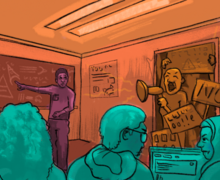Behind Logan Hicks and the Arizona hockey movement
Ally Walsh | Staff Photographer
Logan Hicks, a senior defender, has blocked the third most shots (17) on the team in 2019
Every summer Logan Hicks goes back home. Every summer she sees more. More skaters at local rinks. More opportunities for players in the position she found herself just a few years ago.
Hicks can see how her home state of Arizona is redefining what it means to be a traditional hockey market.
A senior on the Syracuse women’s ice hockey team, Hicks is part of a growing trend of Arizona hockey players becoming collegiate, professional and Olympic hockey players. From 2013-18, Sports Illustrated reported that hockey registration in Arizona increased by 109%, the largest growth of any American state.
While the face of this movement may be Auston Matthews, a moustached 22-year-old playing for the NHL’s Toronto Maple Leafs, the growth of hockey within the state is seen at the youth level. It’s found in the success of local collegiate programs and in the development of future Arizona-born players, like Hicks, who are succeeding at the highest levels across the country.
“When I think about it, yeah it is pretty cool,” Hicks said. “Being from a non-traditional hockey area. But I mean, I’m just proud to be from Arizona.”
In 1996, a relocating Winnipeg Jets franchise found its way to Arizona with only three ice hockey rinks. While the Coyotes have no Stanley Cup banners and a lone Western Conference Finals appearance, in the more than 20 years since, their impact has carried the state into hockey relevance.
Lyndsey Fry, an Arizona-born Olympic silver medalist, estimates that 10 more sheets of ice have popped up in the Phoenix area since the Coyotes were founded, including one in Chandler, where she started skating at 5 years old. Without that rink, and some inspiration from the “Mighty Ducks” film franchise, Fry may never have had the opportunity to play. Without that rink, she would not have been one of the 21 American women who earned silver at the Sochi Olympics in 2014.
“When I was very first starting to play hockey, I didn’t even know what the Olympics were,” Fry said, “I thought I was going to be Shane Doan and play for the Coyotes someday.”
Following the Coyotes’ first years, a dedicated and tight-knit group of Arizona hockey players began to grow. It’s common for NHL players and young hockey players to practice in the same facilities. One time, Hicks even skated with Fry. But Hicks’ hockey dreams were not inspired by an NHL team or Disney film franchise. She was born into the sport.

Karleigh Merritt-Henry | Digital Design Editor
Following Hicks’ father’s professional hockey career, where Alex Hicks played 194 NHL games for five different teams, Hicks and her family moved to Arizona in 2006. Wayne Hicks, Hicks’ grandfather, finished a professional hockey career of his own with four seasons for the WHL’s Phoenix Roadrunners, Arizona’s first professional hockey team.
Lacking opportunities growing up in Germany, she and her father said, Hicks started playing in third grade once she moved to Arizona. Her dad coached her, which benefited both of them.
Alex became an assistant coach at Arizona State in 2014, one year before the Sun Devils’ program was founded. ASU’s team was the fastest ever Division I men’s program to reach the NCAA tournament, and now features three local players. Phoenix native and ASU freshman defenseman Connor Stuart grew up playing road hockey with neighbors on his driveway, but it was support from the Coyotes that motivated his hockey career.
But where the Coyotes failed, until recently, was the development of competitive girls’ programs. Unlike many other states, Arizona didn’t have Triple-A youth teams for girls, so Hicks had to move to St. Louis to continue advancing in the sport.
“It sucks that you don’t have like the competitive girls growing up,” Hicks said. “Where you can start playing with them and practice with them every day.”
Now led by Fry — a brand ambassador and special advisor to the Coyotes — Arizona has taken the next step and introduced more competitive programs to keep talented hockey players in-state through high school. Fry helped create a “Kachinas Program” for girls aged between nine and 19 with the goal of developing more Arizona female hockey stars.
“If we can keep them here,” Fry said. “I think we’re going to be able to do something really special.”
Twenty-three years removed from three rinks and a newly relocated NHL franchise, the seeds of hockey in Arizona are paying off and paying forward. Players like Fry are returning home, looking to give back. As long as players like Hicks continue to return and help promote the sport, hockey will continue to grow in Arizona.
Said Alex: “I think the sky’s the limit.”
Published on October 29, 2019 at 11:42 pm
Contact Mitchell: mbannon@syr.edu





